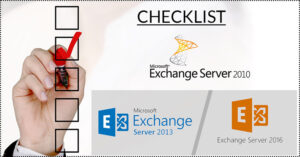Are you searching to know how to mount and dismount Exchange database files? Eager to use a trusted solution to mount or dismount the Exchange EDB files effectively? If yes, this blog will answer your queries and provide simple ways. Actually, the database mounting or dismounting process is common for administrators while carrying out maintenance checkups or restoring data on the Exchange Server 2007, 2010, 2013, 2016, or 2019.
However, if you are willing to accomplish this task without a single problem, you need to mount or dismount EDB using a planned strategy. In case you are unable to follow a genuine plan; various issues can attack and affect accessing Exchange mailboxes. Hence, we urge users to focus on this blog to the end and get a straightforward way to mount or dismount EDB files and fix database mounting issues.
Let’s now explore when to mount and dismount the database:
There are various tasks for which users need to mount or dismount the Exchange database files. We know sharing each one in detail can take longer, so we are going to understand through a simple and basic table.
| Tasks | When to Mount | When to Dismount |
|---|---|---|
| Backup | After finishing the backup task | Before starting the backup |
| Upgrades | Once you have installed a new update | Just before installing the new update |
| Troubleshooting | When you completely resolve the issue | Before addressing the issue |
| Maintenance | After done with the maintenance task | Before going to perform the maintenance process |
| Data Recovery | Once you have completed the data recovery task | When looking to begin the maintenance task |
| Migrating Database | After transferring the database to a new place | Before moving the database to a new drive or location |
| Resource Management | When you need the database for user access | When the Exchange database is not in use |
| Changing Configuration | Once you have made changes in configuration | Before setting up new changes in configuration |
We expect users to know when it is necessary to mount and dismount Exchange database files. So, the time has now come to discuss the stepwise procedure of mounting and dismounting the EDB files.
How to mount the Exchange database on the server?
Users can use two solutions: Exchange Admin Center and PowerShell commands to mount the Exchange EDB file. We will step on each solution one by one in the upcoming section to have a simple and smooth mounting process.
1. Microsoft Exchange Admin Center:
- Open your browser and gear to the Exchange Admin Center.
- Thereafter, make a sign in using administrator account details.
- From the left panel, kindly choose the Servers and click the Databases option.
- Then, select a database from the list to mount.
- After choosing the database, hit the More button and click the Mount from the options.
- A confirmation notification will appear. Click the Yes to grant permission to mount Exchange database files.
- Now, go and ensure the Exchange database items are accessible to the users.
That is the procedure of using the Exchange Admin Center to mount Exchange database files. Users can only mount a single file when performing the above solution.
2. Exchange Management Shell (PowerShell Commands):
Follow the steps below to mount Exchange database files using the Exchange PowerShell commands.
- To begin, open the Exchange Management Shell on your Exchange Server.
- Then, run the following command to check the status of the databases. Using this command, you will be able to see all database statuses, whether they are mounted or dismounted.
Get-MailboxDatabase | Format-List Name, Mounted- After that, run the command below to mount the Exchange database. Also, change the “DatabaseName” to the original name of the database.
Mount-Database -Identity "DatabaseName"- Confirm mounting process has been done successfully by running the following command.
Get-MailboxDatabase | Format-List Name, MountedHow to dismount Exchange database files?
Users can easily dismount Exchange database files in simple way. So, to know the solutions on how to dismount Exchange EDB files, follow the below stepwise guide.
1. Via Exchange Admin Center:
- On the Exchange Admin Center, log in with the admin credentials.
- Then, tap the Servers and hit the Databases option.
- Now, a list of the databases will show on your screen. Find the one you want to dismount and select it.
- After that, hit the More (three dots) option and select the dismount option from the drop-down list.
- Confirm with Yes when you will see a notification to ask for permission to dismount the Exchange database on the server.
The process is almost similar to mounting and dismounting the Exchange database on the server using the Exchange Admin Center. Now, we will share the common PowerShell commands for users to run for dismounting the Exchange database.
2. Microsoft PowerShell Commands:
The upcoming steps will help users dismount Exchange database files using the Exchange Management Shell commands, which are as follows.
- Start with launching the Exchange Management Shell on your server.
- Then, check the database’s status by running the following command.
Get-MailboxDatabase | Format-List Name, Mounted- Now, dismount the Exchange database using the below-shared command. Replace the “DatabaseName” with the actual name of the database file.
Dismount-Database -Identity "DatabaseName"- Run this command to verify whether the database is dismounted or not.
Get-MailboxDatabase | Format-List Name, MountedMounting and dismounting databases through the above solutions can be tricky and put users into trouble. Moreover, users may lose their database items if they do not follow the steps carefully. Users can also fix the mounting Exchange database issues that we have discussed in the next section.
Common solutions to fix Exchange database mounting issues
Users may face some problems when performing the above solutions to mount Exchange database files. We have shared common problems and their solutions in the section below to fix these issues and successfully mount Exchange database files.
1. MapiExceptionDatabaseError: Unable to Mount database:
Why this error: This error generally occurs when the database or log files are missing, corrupted, or have permission issues.
Solution:
- Verifying Log files: Check the database’s log path to ensure the necessary log files are present.
- Check Database Corruption: Run the Eseutil/mh command to check the corruption in the Exchange database file.
- eseutil /mh “path_to_database_file”
- If the result shows dirty, you need to use the Eseutil/p command to fix database corruption.
- eseutil /p “path_to_database_file”
Note: Replace the “path to database file” with the original location of the database file.
2. Database can’t be found:
Why this error: This error indicates that the server is unable to locate the database file. It might be because of an incorrect file path or because the database is not registered.
Solution:
- Make sure that the database and log files are present at the designated location. Also, ensure to check the file directory set up in the Exchange Server.
- In case the database is not registered, you need to re-register it to overcome this mounting issue.
3. Incorrect Permissions:
Why this error: The mounting process might show this error if you fail to provide correct permissions.
Solution:
- The foremost step is to assign roles that allow users to manage the database, like being a member of the Exchange Organization Administrators group. You can use the command below to assign the user a specific Organization Management group membership.
Add-RoleGroupMember -Identity "Organization Management" -Member "username"4. Database files have encountered a failure:
Why this error: If the database goes in a failed state, that means you have previously attempted to mount it multiple times, or it is corrupted.
Solution:
- Use Eseutil commands to repair the database, as shown in the solution to the 1st error we explained.
- Also, you can check even logs to find a specific message error to get to know the reason the database is in a failed state.
5. Active Directory Errors:
Why this error: If the AD replication health issues, you may unable to mount Exchange database files. So, follow the solution below and check the overall health of the Active Directory replication.
Solution:
- First, ensure that the server is connected to the domain and that the domain controllers are available.
- Then, check the Active Directory Replication health by running the command below.
Get-ADReplicationPartnerMetadata -Target "DomainControllerName"6. Data Availability Group Replication issues:
Why this error: As you can easily understand from this error name, users won’t be able to mount the database when there are replication issues in the Data Availability Group.
Solution:
- Check the Data Availability Group (DAG) replication health using the following command.
Get-MailboxDatabaseCopyStatusMoreover, if there is insufficient disk space, you can also face issues properly mounting the database. So, focus on the above section to fix Exchange database mounting issues.
Which is the best and most trusted alternative tool?
We know mounting a database is challenging and can corrupt the EDB file, so having a backup or recovery of the database is very important. The Shoviv EDB to PST Converter Tool offers a number of options to effortlessly backup and restore Exchange EDB files. Whether you mount or dismount Exchange database files, this tool will securely save the data to another place. Moreover, in case the data gets corrupted, you can quickly restore and recover the items from a corrupted database.
Along with converting to PST, the tool also allows users to save EDB file data into EML, MSG, HTML and other file formats. Moreover, this software permits moving the Exchange database files to Office 365 and Live Exchange Server mailboxes. It comes with a filter option, so users can easily choose selected items from the mailbox to process into the target.
Easy steps for using the Shoviv EDB Converter Tool
- Run the Software and Add the EDB files.
- Choose the Outlook PST option.
- Select subfolders and apply filters to include or exclude items.
- Modify conversion settings if needed.
- Review the settings and click the Finish button.
Now is the time to take action!
Whether you are looking to mount or dismount the Exchange database files for any reason, make sure to keep a backup. Or if the file is corrupted, due to which the database needs to be repaired, kindly use the Shoviv EDB to PST Converter Tool. This is a reliable way to save EDB file data into PST and other formats. Moreover, this blog also shares a detailed procedure for mounting and dismounting databases.
Besides that, we also focus on the common issues and their solutions when mounting the Exchange database files. Now, it is your turn to step forward and choose a trusted as well as straightforward way to backup and restore EDB files. Its free trial version is also available to test, so try it and process the first 50 items per folder to know what this solution facilitates.
- Outlook Archiving Not Working! What Should I Do to Fix it? - June 20, 2025
- How to Repair Outlook Calendar When It’s Not Responding? - June 11, 2025
- How to Copy SharePoint Page to Another Site? - June 7, 2025


